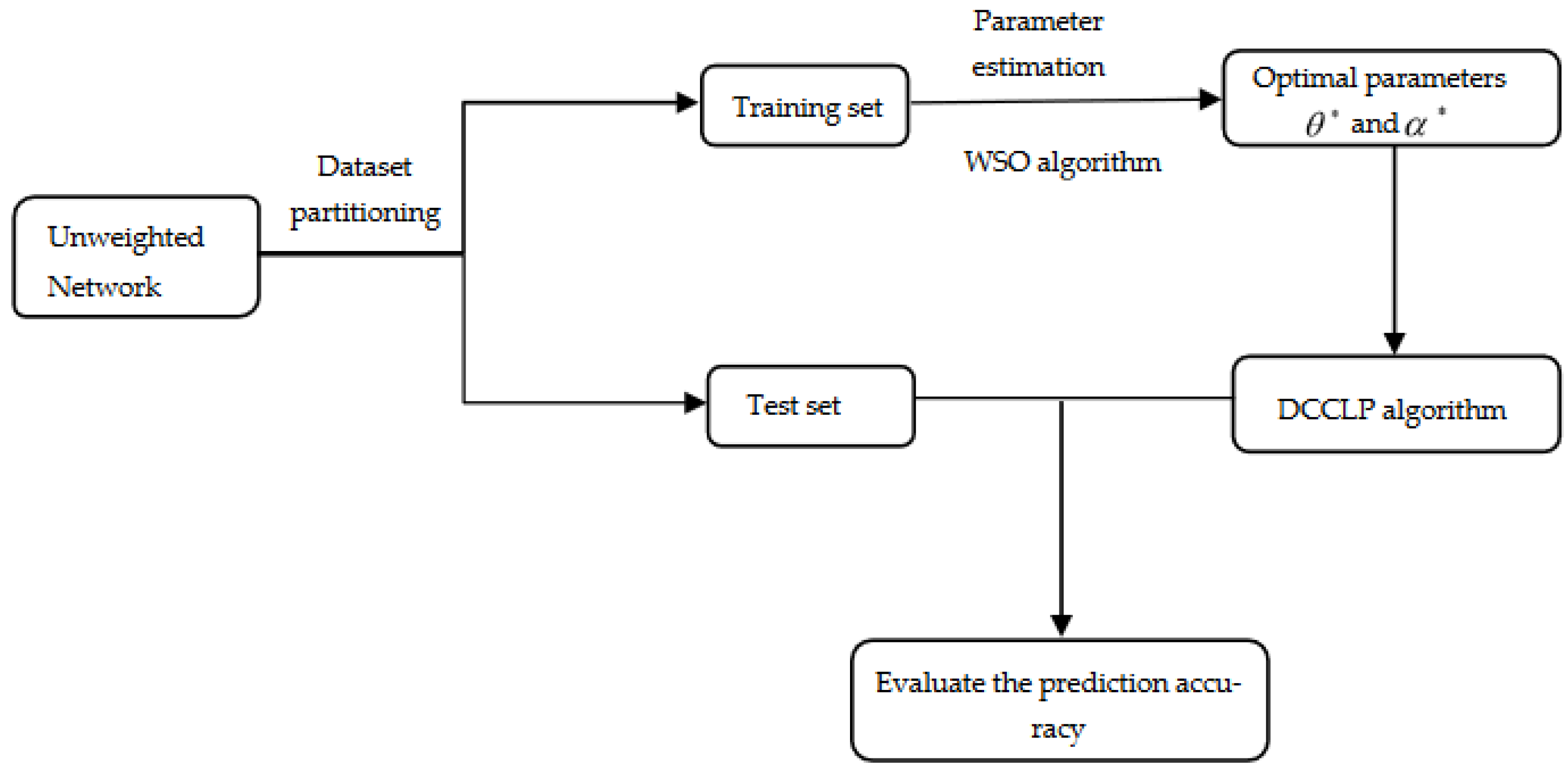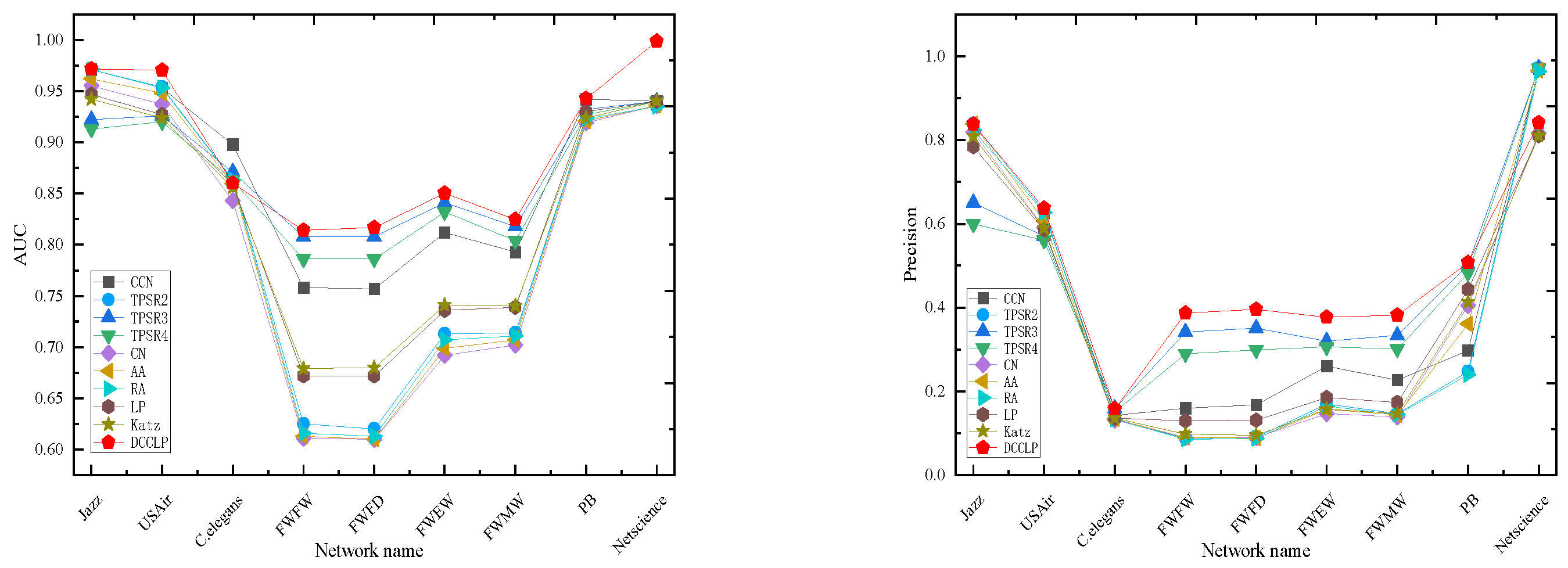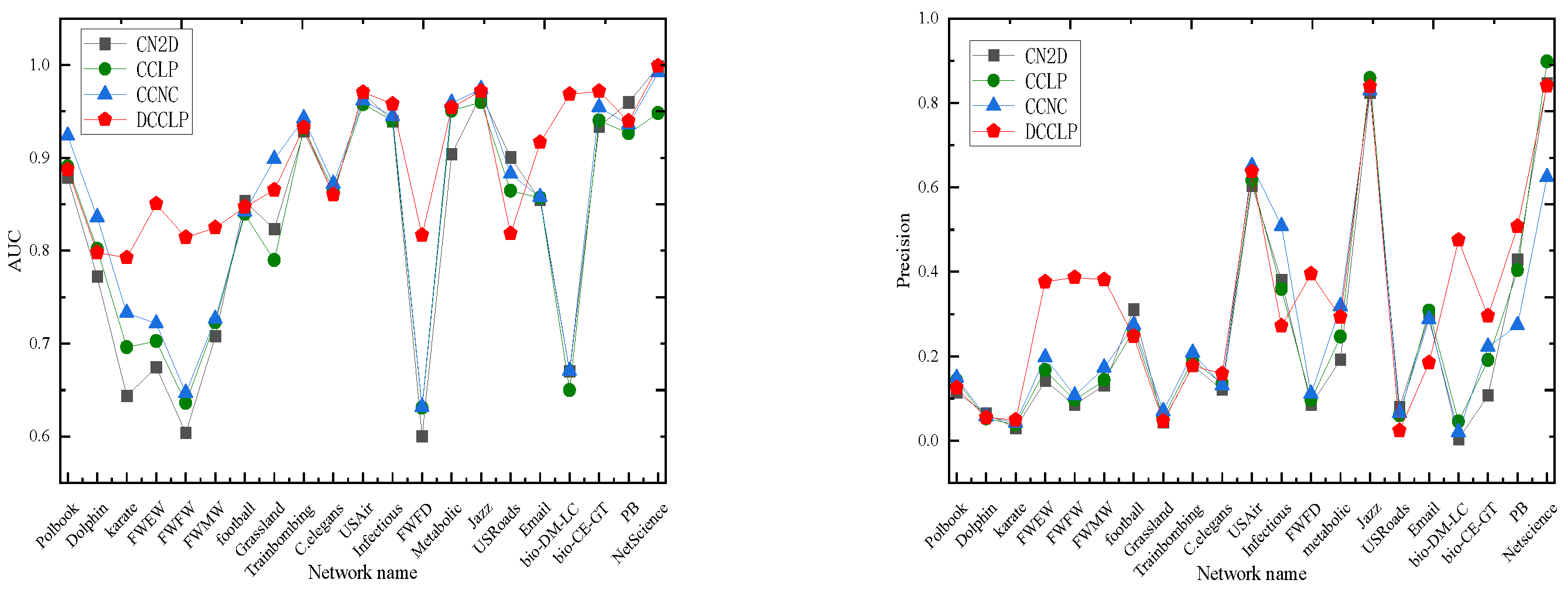Integrating Node Importance and Network Topological Properties for Link Prediction in Complex Network
Abstract
1. Introduction
2. The TPSR3 Algorithm
3. The DCCLP Algorithm
4. The Parameter Estimation of DCCLP Algorithm
5. Experimental Results and Analysis
- (1)
- Comparison of prediction accuracy between DCCLP algorithm and algorithms in [17]
- (2)
- Comparison of the DCCLP algorithm with existing algorithms
6. Conclusions
Author Contributions
Funding
Data Availability Statement
Acknowledgments
Conflicts of Interest
References
- Rossetti, G.; Cazabet, R. Community discovery in dynamic networks: A survey. ACM Comput. Surv. 2018, 51, 1–37. [Google Scholar] [CrossRef]
- Shakibian, H.; Moghadam Charkari, N. Mutual information model for link prediction in heterogeneous complex networks. Sci. Rep. 2017, 7, 44981. [Google Scholar] [CrossRef]
- Zareie, A.; Sheikhahmadi, A.; Jalili, M. Influential node ranking in social networks Based on neighborhood diversity. Future Gener. Comput. Syst. 2019, 94, 120–129. [Google Scholar] [CrossRef]
- Zhang, F.; Liu, J.; Zuo, C. Research of complex network dynamics evolution. In Information Engineering and Applications; Springer: London, UK, 2012; pp. 806–815. [Google Scholar]
- Lü, L. Link Prediction on Complex networks. J. Univ. Electron. Sci. Technol. China 2010, 39, 651–661. [Google Scholar]
- Clauset, A.; Moore, C.; Newman, M.E.J. Hierarchical structure and the prediction of Missing links in networks. Nature 2008, 453, 98–101. [Google Scholar] [CrossRef] [PubMed]
- Zhang, D.; Yin, J.; Zhu, X.; Zhang, C. Network representation learning: A survey. IEEE Trans. Big Data 2018, 6, 3–28. [Google Scholar] [CrossRef]
- Rapoport, A. Spread of information through a population with socio-structural bias: I. Assumption of transitivity. Bull. Math. Biol. 1953, 15, 523–533. [Google Scholar] [CrossRef]
- Adamic, L.A.; Adar, E. Friends and neighbors on the Web. Soc. Netw. 2003, 25, 211–230. [Google Scholar] [CrossRef]
- Zhou, T.; Lü, L.; Zhang, Y.C. Predicting missing links via local information. Eur. Phys. J. B 2009, 71, 623–630. [Google Scholar] [CrossRef]
- Gao, Y.; Zhang, Y.P.; Qian, F.L.; Zhao, S. Combined with Node Degree and Node Clustering of Link Prediction Algorithm. J. Chin. Comput. Syst. 2017, 38, 1436–1441. [Google Scholar]
- Yu, Y.; Wang, Y.G.; Luo, Z.G.; Yang, Y.; Wang, X.; Gao, T.; Yu, Q. Link Prediction algorithm based on clustering coefficient and node centrality. J. Tsinghua Univ. (Sci. Technol.) 2022, 62, 98–104. [Google Scholar]
- Katz, L. A new status index derived from sociometric analysis. Psychometrika 1953, 18, 39–43. [Google Scholar] [CrossRef]
- Brin, S.; Page, L. The anatomy of a large-scale hypertextual web search engine. Comput. Netw. ISDN Syst. 1998, 30, 107–117. [Google Scholar] [CrossRef]
- Lv, L.Y.; Jin, C.H.; Zhou, T. Similarity index based on local paths for link prediction of Complex networks. Phys. Rev. E 2009, 80, 046122. [Google Scholar]
- Liu, W.; Lv, L.Y. Link prediction based on local random walk. Europhys. Lett. 2010, 89, 58007. [Google Scholar] [CrossRef]
- Qian, F.; Gao, Y.; Zhao, S.; Tang, J.; Zhang, Y. Combining topological properties and strong ties for Link prediction. Tsinghua Sci. Technol. 2017, 22, 595–608. [Google Scholar] [CrossRef]
- Wu, Z.; Lin, Y.; Wang, J.; Gregory, S. Link prediction with node clustering coefficient. Phys. A Stat. Mech. Its Appl. 2016, 452, 1–8. [Google Scholar] [CrossRef]
- Mumin, D.; Shi, L.L.; Liu, L. An efficient algorithm for link prediction based on local Information: Considering the effect of node degree. Concurr. Comput. Pract. Exp. 2022, 34, 6289. [Google Scholar] [CrossRef]
- Liu, Y.; Liu, S.; Yu, F.; Yang, X. Link prediction algorithm based on the initial information Contribution of nodes. Inf. Sci. 2022, 608, 1591–1616. [Google Scholar] [CrossRef]
- Fu, X.Y.; Gu, Y.J. Unsupervised Link Prediction Algorithm Fusing Node Importance. Comput. Eng. Appl. 2022, 58, 94–101. [Google Scholar]
- Liu, B.; Xu, S.; Li, T.; Xiao, J.; Xu, X.K. Quantifying the effects of topology and weight for link prediction in weighted complex networks. Entropy 2018, 20, 363. [Google Scholar] [CrossRef] [PubMed]
- Samei, Z.; Jalili, M. Application of hyperbolic geometry in link prediction of multiplex networks. Sci. Rep. 2019, 9, 12604. [Google Scholar] [CrossRef] [PubMed]
- Braik, M.; Hammouri, A.; Atwan, J.; Al-Betar, M.A.; Awadallah, M.A. White Shark Optimizer: A novel bio-inspired metaheuristic algorithm for global optimization problems. Knowl.-Based Syst. 2022, 243, 108457. [Google Scholar] [CrossRef]



| Networks | CCN | TPSR2 | TPSR3 | TPSR4 | CN | AA | RA | LP (0.01) | Katz (0.01) | DCCLP θ*, α* |
|---|---|---|---|---|---|---|---|---|---|---|
| Jazz | 0.9710 | 0.9710 | 0.9220 | 0.9130 | 0.9550 | 0.9620 | 0.9710 | 0.9470 | 0.9420 | 0.9720 (0.0001, 1) |
| USAir | 0.9530 | 0.9540 | 0.9260 | 0.9200 | 0.9370 | 0.9480 | 0.9530 | 0.9270 | 0.9240 | 0.9703 (0.0013, 0.9798) |
| C. elegans | 0.8980 | 0.8640 | 0.8710 | 0.8630 | 0.8430 | 0.8600 | 0.8630 | 0.8590 | 0.8560 | 0.8602 (0.0422, 0.9242) |
| FWFW | 0.7580 | 0.6250 | 0.8080 | 0.7860 | 0.6110 | 0.6130 | 0.6160 | 0.6720 | 0.6790 | 0.8143 (0.0943, 0.0290) |
| FWFD | 0.7570 | 0.6200 | 0.8080 | 0.7860 | 0.6100 | 0.6100 | 0.6130 | 0.6720 | 0.6800 | 0.8168 (0.0819, 0.0478) |
| FWEW | 0.8120 | 0.7130 | 0.8410 | 0.8320 | 0.6920 | 0.6990 | 0.7070 | 0.7360 | 0.7410 | 0.8505 (0.0713, 0.0042) |
| FWMW | 0.7930 | 0.7140 | 0.8180 | 0.8040 | 0.7020 | 0.7070 | 0.7110 | 0.7390 | 0.7400 | 0.8249 (0.0829, 0.0571) |
| PB | 0.9420 | 0.9230 | 0.9320 | 0.9270 | 0.9190 | 0.9210 | 0.9230 | 0.9300 | 0.9240 | 0.9430 (0.0366, 0.7578) |
| Netscience | 0.9400 | 0.9350 | 0.9400 | 0.9400 | 0.9360 | 0.9360 | 0.9350 | 0.9400 | 0.9400 | 0.9989 (0.0822, 0.0160) |
| Networks | CCN | TPSR2 | TPSR3 | TPSR4 | CN | AA | RA | LP (0.01) | Katz (0.01) | DCCLP θ*, α* |
|---|---|---|---|---|---|---|---|---|---|---|
| Jazz | 0.8240 | 0.8380 | 0.6500 | 0.6000 | 0.8190 | 0.8380 | 0.8240 | 0.7840 | 0.8090 | 0.8390 (0.0001, 1) |
| USAir | 0.6270 | 0.6310 | 0.5710 | 0.5610 | 0.5910 | 0.6070 | 0.6270 | 0.5860 | 0.5900 | 0.6374 (0.0013, 0.9798) |
| C. elegans | 0.1430 | 0.1330 | 0.1590 | 0.1520 | 0.1320 | 0.1340 | 0.1330 | 0.1360 | 0.1360 | 0.1587 (0.0422, 0.9242) |
| FWFW | 0.1600 | 0.0880 | 0.3420 | 0.2900 | 0.0900 | 0.0900 | 0.0860 | 0.1300 | 0.0980 | 0.3868 (0.0943, 0.0290) |
| FWFD | 0.1680 | 0.0910 | 0.3510 | 0.2990 | 0.0900 | 0.0890 | 0.0870 | 0.1310 | 0.0950 | 0.3955 (0.0819, 0.0478) |
| FWEW | 0.2600 | 0.1700 | 0.3200 | 0.3060 | 0.1470 | 0.1570 | 0.1650 | 0.1850 | 0.1580 | 0.3768 (0.0713, 0.0042) |
| FWMW | 0.2270 | 0.1470 | 0.3340 | 0.3010 | 0.1390 | 0.1440 | 0.1450 | 0.1740 | 0.1470 | 0.3818 (0.0829, 0.0571) |
| PB | 0.2980 | 0.2470 | 0.5030 | 0.4830 | 0.4050 | 0.3610 | 0.2400 | 0.4430 | 0.4130 | 0.5075 (0.0366, 0.7578) |
| Netscience | 0.9700 | 0.9720 | 0.9710 | 0.9710 | 0.8160 | 0.9660 | 0.9640 | 0.8100 | 0.8100 | 0.8409 (0.0822, 0.0160) |
| Networks | D | H | |||||
|---|---|---|---|---|---|---|---|
| Polbook | 105 | 441 | 8.400 | 0.4875 | 0.0808 | 1.4207 | 3.0788 |
| Dolphin | 62 | 159 | 5.129 | 0.3852 | 0.0841 | 1.3243 | 3.1089 |
| karate | 34 | 78 | 4.5882 | 0.6001 | 0.1390 | 1.6933 | 2.4082 |
| FWEW | 69 | 880 | 25.5072 | 0.5521 | 0.3751 | 1.2746 | 1.636 |
| FWFW | 128 | 2075 | 32.4219 | 0.3346 | 0.2553 | 1.2370 | 1.7763 |
| FWMW | 97 | 1446 | 29.8144 | 0.4683 | 0.3106 | 1.2656 | 1.6929 |
| football | 115 | 613 | 10.6609 | 0.4032 | 0.0935 | 1.0069 | 2.5082 |
| Grassland | 75 | 114 | 3.0400 | 0.8198 | 0.0411 | 2.7499 | 3.1996 |
| Trainbombing | 64 | 243 | 7.5938 | 0.7473 | 0.1205 | 1.6588 | 2.691 |
| C. elegans | 297 | 2148 | 14.4646 | 0.3429 | 0.0489 | 1.8008 | 2.4553 |
| USAir | 332 | 2126 | 12.8072 | 0.7909 | 0.0387 | 3.4639 | 2.7381 |
| Infectious | 410 | 2765 | 13.4878 | 0.4802 | 0.0330 | 1.3876 | 3.6309 |
| FWFD | 128 | 2106 | 32.9063 | 0.3346 | 0.2591 | 1.2307 | 1.7724 |
| Metabolic | 453 | 2025 | 8.9404 | 0.6597 | 0.0198 | 4.485 | 2.6638 |
| Jazz | 198 | 2742 | 27.6970 | 0.6427 | 0.1406 | 1.3951 | 2.235 |
| US Roads | 49 | 107 | 4.3673 | 0.5171 | 0.0910 | 1.1299 | 4.1633 |
| PB | 1222 | 16,714 | 27.3552 | 0.4307 | 0.0224 | 2.9707 | 2.7375 |
| Netscience | 1589 | 2742 | 3.4512 | 0.8310 | 0.0022 | 2.0105 | 0.3514 |
| 1133 | 5451 | 9.6222 | 0.3535 | 0.0085 | 1.9421 | 3.606 | |
| Bio-DM-LC | 658 | 1129 | 3.4316 | 0.5166 | 0.0052 | 3.1149 | 3.5637 |
| Bio-CE-GT | 924 | 3239 | 7.0108 | 0.6820 | 0.0076 | 4.1392 | 3.3724 |
| Networks | CN2D | CCLP | CCNC | DCCLP θ*, α* |
|---|---|---|---|---|
| Polbook | 0.8791 | 0.8908 | 0.9240 [12] | 0.8876 (0.0826, 0.7284) |
| Dolphin | 0.7722 | 0.8020 [18] | 0.8360 [12] | 0.7981 (0.0883, 0.0735) |
| karate | 0.6441 | 0.6960 | 0.7332 | 0.7925 (0.0960, 0.0784) |
| FWEW | 0.6750 | 0.7026 | 0.7216 | 0.8505 (0.0713, 0.0042) |
| FWFW | 0.6042 | 0.6362 [18] | 0.6470 [12] | 0.8143 (0.0943, 0.290) |
| FWMW | 0.7079 | 0.7229 | 0.7267 | 0.8249 (0.0829, 0.0571) |
| football | 0.8535 | 0.8397 | 0.8420 | 0.8472 (0.0834, 0.002) |
| Grassland | 0.8236 | 0.7900 [18] | 0.8987 | 0.8655 (0.0891, 0.0606) |
| Trainbombing | 0.9283 | 0.9317 | 0.9424 | 0.9328 (0.0296, 0.9077) |
| C. elegans | 0.8613 [19] | 0.8658 | 0.8721 | 0.8602 (0.0422, 0.9242) |
| USAir | 0.9695 [19] | 0.9576 | 0.9620 [12] | 0.9703 (0.0013, 0.9798) |
| Infectious | 0.9393 | 0.9399 | 0.9447 | 0.9579 (0.0156, 0.6831) |
| FWFD | 0.6003 | 0.6308 | 0.6318 | 0.8168 (0.0819, 0.0478) |
| metabolic | 0.9039 | 0.9507 | 0.9592 | 0.9542 (0.0034, 1.0000) |
| Jazz | 0.9685 [19] | 0.9600 [18] | 0.9740 [12] | 0.9716 (0.0001, 1.000) |
| USRoads | 0.9007 | 0.8647 | 0.8829 | 0.8182 (0.0892, 0.0566) |
| 0.8546 | 0.8570 [18] | 0.8578 | 0.9168 (0.0504, 0.5232) | |
| bio-DM-LC | 0.6701 | 0.6498 | 0.6707 | 0.9684 (0.0411, 0.0007) |
| bio-CE-GT | 0.9341 | 0.9403 | 0.9547 | 0.9717 (0.0168, 0.7671) |
| PB | 0.9599 [19] | 0.9266 [18] | 0.9360 [12] | 0.9397 (0.0366, 0.7578) |
| Netscience | 0.9981 [19] | 0.9480 | 0.9920 | 0.9989 (0.0822, 0.0160) |
| Networks | CN2D | CCLP | CCNC | DCCLP θ*, α* |
|---|---|---|---|---|
| Polbook | 0.1145 | 0.1426 | 0.1485 | 0.1257 (0.0826, 0.7284) |
| Dolphin | 0.0646 | 0.0528 | 0.0576 | 0.0551 (0.0883, 0.0735) |
| karate | 0.0307 | 0.0385 | 0.0424 | 0.0489 (0.0960, 0.0784) |
| FWEW | 0.1423 | 0.1671 | 0.1978 | 0.3768 (0.0713, 0.0042) |
| FWFW | 0.0853 | 0.0970 [18] | 0.1068 | 0.3868 (0.0943, 0.290) |
| FWMW | 0.1320 | 0.1440 | 0.1735 | 0.3818 (0.0829, 0.0571) |
| football | 0.3112 | 0.2619 | 0.2738 | 0.2477 (0.0834, 0.002) |
| Grassland | 0.0441 | 0.0565 | 0.0698 | 0.0465 (0.0891, 0.0606) |
| Trainbombing | 0.1791 | 0.1912 | 0.2083 | 0.1777 (0.0296, 0.9077) |
| C. elegans | 0.1213 | 0.1356 | 0.1316 | 0.1587 (0.0422, 0.9242) |
| USAir | 0.6046 | 0.6166 | 0.6503 | 0.6374 (0.0013, 0.9798) |
| Infectious | 0.3803 | 0.3592 | 0.5083 | 0.2720 (0.0156, 0.6831) |
| FWFD | 0.0862 | 0.0967 | 0.1109 | 0.3955 (0.0819, 0.0478) |
| metabolic | 0.1918 | 0.2467 | 0.3188 | 0.2929 (0.0034, 1.0000) |
| Jazz | 0.8243 | 0.8590 [18] | 0.8297 | 0.8385 (0.0001, 1.000) |
| USRoads | 0.0800 | 0.0603 | 0.0657 | 0.0238 (0.0892, 0.0566) |
| 0.2953 | 0.3080 [18] | 0.2878 | 0.1850 (0.0504, 0.5232) | |
| bio-DM-LC | 0.0043 | 0.0456 | 0.0207 | 0.4751 (0.0411, 0.0007) |
| bio-CE-GT | 0.1076 | 0.1911 | 0.2228 | 0.2961 (0.0168, 0.7671) |
| PB | 0.4288 | 0.4040 [18] | 0.2732 | 0.5075 (0.0366, 0.7578) |
| Netscience | 0.8464 | 0.8982 | 0.6241 | 0.8409 (0.0822, 0.0160) |
Disclaimer/Publisher’s Note: The statements, opinions and data contained in all publications are solely those of the individual author(s) and contributor(s) and not of MDPI and/or the editor(s). MDPI and/or the editor(s) disclaim responsibility for any injury to people or property resulting from any ideas, methods, instructions or products referred to in the content. |
© 2023 by the authors. Licensee MDPI, Basel, Switzerland. This article is an open access article distributed under the terms and conditions of the Creative Commons Attribution (CC BY) license (https://creativecommons.org/licenses/by/4.0/).
Share and Cite
Zhu, J.; Dai, F.; Zhao, F.; Guo, W. Integrating Node Importance and Network Topological Properties for Link Prediction in Complex Network. Symmetry 2023, 15, 1492. https://doi.org/10.3390/sym15081492
Zhu J, Dai F, Zhao F, Guo W. Integrating Node Importance and Network Topological Properties for Link Prediction in Complex Network. Symmetry. 2023; 15(8):1492. https://doi.org/10.3390/sym15081492
Chicago/Turabian StyleZhu, Junxi, Fang Dai, Fengqun Zhao, and Wenyan Guo. 2023. "Integrating Node Importance and Network Topological Properties for Link Prediction in Complex Network" Symmetry 15, no. 8: 1492. https://doi.org/10.3390/sym15081492
APA StyleZhu, J., Dai, F., Zhao, F., & Guo, W. (2023). Integrating Node Importance and Network Topological Properties for Link Prediction in Complex Network. Symmetry, 15(8), 1492. https://doi.org/10.3390/sym15081492





